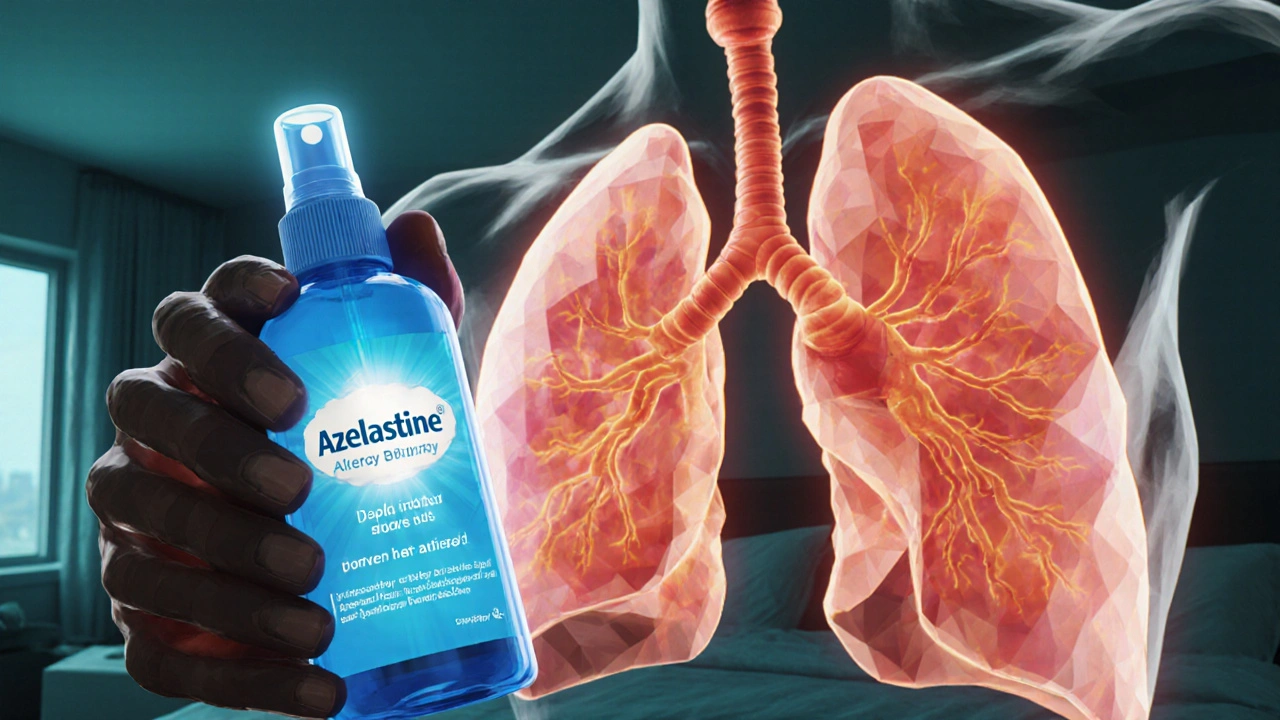Azelastine Bronchitis Benefit Calculator
This calculator helps you understand if azelastine nasal spray might provide benefit for your bronchitis symptoms based on your specific condition and symptoms. Remember: azelastine is not a treatment for bronchitis itself but may help with allergy-related triggers.
Your Symptoms
When you hear the word azelastine, you probably think of allergy relief, not lung infections. Yet many people wonder if this antihistamine can help-or hurt-their bronchitis symptoms. This article untangles the science, looks at real‑world use, and gives you a clear picture of what to expect if azelastine meets bronchitis.
What Is Azelastine?
Azelastine is a second‑generation antihistamine that works by blocking H1 receptors, preventing histamine from triggering inflammation in the nasal passages and eyes. It is most commonly delivered as a nasal spray or eye drops, and it’s available over the counter in many countries.
Key attributes of azelastine:
- Typical dosage: 1-2 sprays per nostril twice daily
- Onset of relief: 15-30 minutes for nasal itching, up to 24 hours for full anti‑inflammatory effect
- Common brand names: Astelin, Astepro, Azelast
Understanding Bronchitis
Bronchitis is an inflammation of the bronchial tubes, which carry air to and from the lungs. It can be acute (usually viral, lasting a few weeks) or chronic (often linked to smoking or long‑term irritants, persisting for months or years).
Typical bronchitis symptoms include a persistent cough, production of mucus, shortness of breath, and chest discomfort. The inflammation is driven by irritation, infection, and immune‑mediated release of chemicals like histamine, leukotrienes, and cytokines.
How Histamine Plays a Role in Bronchitis
While histamine is famous for causing sneezing and itching, it also contributes to airway narrowing and mucus production. When the immune system reacts to a virus or irritant, mast cells release histamine, which binds to H1 receptors on bronchial smooth muscle and leads to cough reflex sensitization.
Because azelastine blocks H1 receptors, it theoretically could dampen part of the inflammatory cascade in the lower airways. However, the drug is formulated to stay in the nasal cavity, and only a tiny fraction reaches the lungs.

Does Azelastine Treat Bronchitis Directly?
Clinical guidelines for bronchitis focus on:
- Rest, hydration, and supportive care for viral acute bronchitis
- Bronchodilators (e.g., albuterol) for wheezing or asthma‑like symptoms
- Antibiotics only when a bacterial infection is confirmed
- Inhaled steroids for chronic bronchitis with COPD features
There is no strong evidence that azelastine, taken as a nasal spray, reduces cough frequency or improves lung function in bronchitis patients. Small pilot studies have noted modest relief of upper‑airway symptoms (post‑nasal drip, sore throat) that can aggravate a cough, but these effects are indirect.
In short, azelastine is not a primary treatment for bronchitis, but it may help if you have simultaneous allergic rhinitis that worsens throat irritation.
When Azelastine Might Be Helpful for Bronchitis‑Related Discomfort
If you experience both allergic nasal congestion and a bronchitic cough, using azelastine can provide the following benefits:
- Reduced post‑nasal drip: Less mucus dripping down the throat means fewer triggers for the cough reflex.
- Improved nasal breathing: Easier airflow can lessen the effort of breathing through the mouth, which can irritate the throat.
- Adjunct relief: When paired with a bronchodilator, patients report feeling “less itchy” in the throat.
These benefits are most noticeable in people with a history of allergic rhinitis, seasonal allergies, or sinusitis that overlaps with bronchitis episodes.
Potential Risks and Side Effects
Even though azelastine is generally safe, you should be aware of common side effects and drug interactions:
| Aspect | Azelastine (nasal spray) | Bronchodilator (e.g., albuterol) | Oral Antibiotic (e.g., amoxicillin) |
|---|---|---|---|
| Typical side effects | Bitterness, nasal irritation, mild drowsiness | Tremor, rapid heartbeat, nervousness | Diarrhea, rash, yeast infection |
| Serious adverse events | Rare anaphylaxis, severe nasal ulceration | Paradoxical bronchospasm | Clostridioides difficile colitis |
| Drug interactions | CYP3A4 inhibitors may increase levels | Beta‑blockers can blunt effect | Oral contraceptives may be less effective |
Because azelastine is a topical agent, systemic interactions are uncommon, but always check with a pharmacist if you’re on multiple prescriptions.
Practical Tips for Using Azelastine When You Have Bronchitis
- Start with a clean nose: Blow out mucus before each spray to improve absorption.
- Use the correct dose: One or two sprays per nostril twice a day; avoid exceeding the label recommendation.
- Combine wisely: If you need a bronchodilator, use it at least 30 minutes before or after the spray to prevent spray‑related irritation.
- Watch for drowsiness: Azelastine can cause mild sedation in a small percentage of users; avoid driving if you feel off.
- Know when to stop: If symptoms persist beyond 10‑14 days or worsen, seek medical attention-azelastine won’t cure an infection.
Frequently Asked Questions
Can azelastine cure bronchitis?
No. Azelastine eases nasal allergy symptoms, which can indirectly reduce cough triggers, but it does not treat the underlying infection or inflammation of the bronchial tubes.
Is it safe to use azelastine while taking antibiotics for bronchitis?
Generally yes. Because azelastine works locally in the nose, it doesn’t interfere with most antibiotics. However, discuss any potential allergies or rare interactions with your pharmacist.
What is the difference between azelastine nasal spray and inhaled antihistamines?
Inhaled antihistamines (still experimental) aim to deposit the drug deeper into the lungs, whereas azelastine stays in the nasal cavity. The latter is approved, cheaper, and has a well‑known safety profile.
How long should I keep using azelastine for bronchitis‑related symptoms?
Use it until your nasal allergy symptoms improve, typically 7‑10 days. If cough persists beyond two weeks, see a clinician for further evaluation.
Can children with bronchitis use azelastine?
Azelastine nasal spray is approved for children as young as 6years for allergic rhinitis. For bronchitis, always get pediatric guidance; the drug may help with allergic symptoms but is not a primary treatment.
Bottom Line
If you’re battling bronchitis and also suffer from allergies, azelastine can be a handy sidekick-reducing post‑nasal drip and soothing irritated throats. It won’t replace antibiotics, bronchodilators, or steroids when those are truly needed. Use it as directed, stay alert for side effects, and consult a healthcare professional if your cough sticks around longer than expected.


Henry Clay
October 15, 2025 AT 12:53If you ignore the lack of evidence, you’re just selling snake‑oil 😂
Isha Khullar
October 15, 2025 AT 22:03We all chase quick fixes, yet the truth hides in the shadows of our own denial – a moral abyss that swallows the careless, defiantly ignoring science!
Lila Tyas
October 16, 2025 AT 07:13Hey everyone, if you’re battling a stubborn cough while your nose won’t quit sneezing, azelastine might just be the sidekick you didn’t know you needed.
The nasal spray works where allergies live, drying up that post‑nasal drip that constantly tickles the back of your throat.
By cutting down the drip, you’re basically removing one of the main triggers that keeps your cough reflex on high alert.
That alone can make a night of sleep feel like a win, especially when you’re already fighting the fatigue that comes with bronchitis.
Remember, though, that azelastine stays in the nasal cavity – it isn’t designed to travel deep into the lungs like an inhaled bronchodilator.
So don’t expect it to magically shrink inflamed bronchial tubes or cure a viral infection.
Think of it as a supporting player, like a backup singer who harmonizes with the main act – the bronchodilator, rest, and hydration.
In practice, use the spray twice a day, after you’ve cleared out any mucus to let the medication coat the lining efficiently.
If you feel a tingle or a slight bitterness, that’s normal and usually fades within a few minutes.
Some folks report a mild drowsy feeling, so if you’re driving or operating machinery, give yourself a short trial period first.
For chronic bronchitis patients who also suffer from seasonal allergies, pairing azelastine with their usual inhaled steroids has been shown to improve overall comfort.
However, always double‑check with your doctor before stacking treatments, especially if you’re on other nasal medications.
And if your cough drags on past two weeks, that’s a red flag – you might need antibiotics or a different therapeutic approach.
Bottom line: azelastine isn’t a cure, but it can trim the irritation from the upper airway, making your other treatments work better.
Stay hydrated, rest up, and give that spray a fair trial – you might be surprised at how much smoother breathing feels.
Mark Szwarc
October 16, 2025 AT 16:23Just to add a quick clarification, the studies mentioned are small pilot trials, not large‑scale randomized controlled trials, so the evidence remains tentative.
BLAKE LUND
October 17, 2025 AT 01:33Picture this: a rain‑soaked street in monsoon‑bustling Mumbai, where the air smells of spices and humidity, and you’re wiping a runny nose while a stubborn cough clings to you like gum on a shoe.
Veronica Rodriguez
October 17, 2025 AT 10:43That’s a vivid scene! 🌧️ In such climates, azelastine can be a lifesaver for the nasal drip that otherwise fuels the cough, just remember to keep the nozzle clean.
Holly Hayes
October 17, 2025 AT 19:53Honestly, if you’re still reading about “simple” nasal sprays, you’re probably stuck in a pre‑digital mindset – modern pharmacology is far beyond such pedestrian chatter.
Matthew Shapiro
October 18, 2025 AT 05:03While the tone may seem lofty, the practical point stands: azelastine’s primary benefit is alleviating allergic rhinitis, not directly treating bronchial inflammation.
Julia Phillips
October 18, 2025 AT 14:13When I was recovering from a harsh bout of bronchitis last winter, the relentless cough made even sipping tea feel like a battle; discovering that a humble nasal spray could calm the post‑nasal drip was a revelation that turned sleepless nights into bearable evenings.
Rory Martin
October 18, 2025 AT 23:23One must also consider that many of these “studies” are funded by pharmaceutical giants who profit from the endless cycle of symptom management rather than true cures, a fact conveniently omitted from mainstream discourse.
Maddie Wagner
October 19, 2025 AT 08:33Let’s remember that every patient’s journey is unique, and while azelastine can help some with concurrent allergies, it should never replace professional medical advice; a collaborative approach with your healthcare team ensures safety and efficacy.
Boston Farm to School
October 19, 2025 AT 17:43Indeed, integrating cultural practices such as steam inhalation alongside azelastine can further soothe the airway, and maintaining proper nasal hygiene maximizes the spray’s local action 🙂